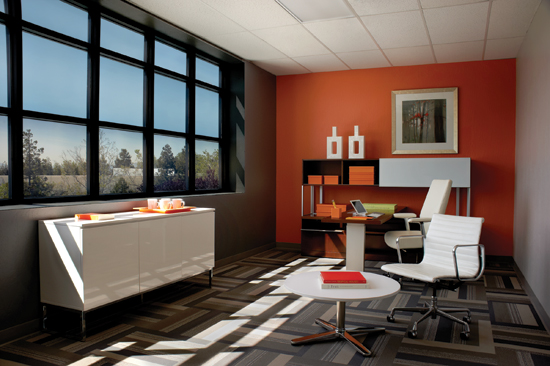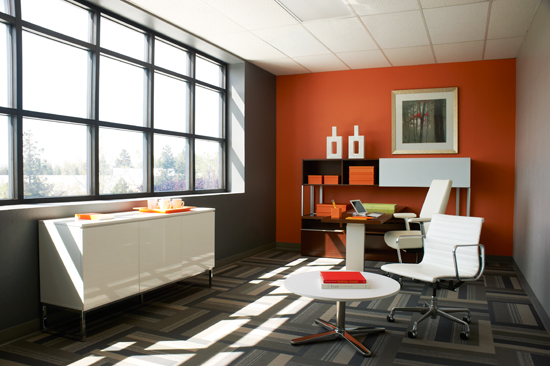The Move to Dynamic Glass
Dynamic Glass—The Beneficiaries
The advantages of dynamic glass extend to three main groups—architects, building managers, and occupants.
Building Designers
Dynamic glass offers greater freedom, enabling architects to use more glass with confidence in striking design solutions while still meeting the performance objectives of building energy codes and standards.
With the use of dynamic glass, shading devices, both external and internal, can be reduced or eliminated. Devices like external blinds and louvers block direct views. When required, dynamic glass can be deployed in its fully tinted state, taking advantage of its low shading coefficient thereby minimizing solar gains and essentially obviating the need for external shades. This not only reduces the purchase cost of the shading devices but also eliminates the added maintenance costs.
With the use of dynamic glass, internal blinds can also be reduced or totally eliminated. Typical office buildings have some type of interior solar control devices such as mini-blinds or roller shades, the management of which is often left to the user. While considered solar control devices, these devices are primarily used for glare mitigation and privacy. Research has shown that in many cases once the blinds are dropped they remain closed for extended periods of time, limiting the potential to tie the performance of the lighting system to outside conditions. A December 2013 study by the Urban Green Council called Seduced By the View looked at 55 glass buildings in New York and found that on average, 59 percent of the window area was covered by blinds or shades, with more than 75 percent of buildings having more than half of their window area covered regardless of time of day, direction the window faced, and whether the building was commercial or residential. The Council concludes that “New Yorkers are paying for more glass and then pulling down the shades.” This results in excessive interior lighting usage as well as loss of passive solar heat in the winter. Society, too, is paying a price: Windows insulate poorly, waste energy, and cause carbon pollution.
A better solution is an integrated approach in which lighting, HVAC, natural ventilation, and dynamic glass control integrate to offer optimum thermal management. In fact, some designers have gone as far as stating that the façade of a building is actually a component of the HVAC system—a philosophy that is only strengthened by the use of dynamic glass. With such an integrated design approach, other energy-intensive building systems can be reduced and simplified often resulting in little or no additional project cost. Peak loads can be reduced, night flushing can be employed, and material-intensive shading systems can be eliminated. As such, dynamic glass serves as an enabling technology for Net-Zero Energy Project goals. For architects seeking green building certifications, dynamic glass can assist in achieving multiple LEED credits due to benefits such as reduced energy consumption, user controllability, improved thermal comfort, and daylighting. Because dynamic glass touches so many elements of the building's design and operation, it can contribute to eight LEED credit categories and potentially offer between 12-22 points.
To meet aesthetic demands, large, 5 feet by 10 feet dynamic glass units are available. Proprietary advances in coating technology, IGU design and control have enabled large glass units that are active edge-to-edge without internal conductors that interrupt the view, providing the aesthetic, performance, and size needed for the next generation of user-centered, environmentally sensitive buildings. This is an important consideration, as across every building sector, owners are continuously innovating to create landmark environments that emphasize beauty in design, openness and natural light, and a commitment to sustainability and the external environment.
Building Management
In addition to providing the aforementioned optimum energy performance and associated cost savings, dynamic glass systems offer a building manager flexibility. They can be operated in modes from manual only to fully automated and integrated with the building management system. User interfaces are via a wall switch, mobile app, or web interface. The system can be configured to maximize comfort, can be easily zoned and rezoned, and adjusted for weekend settings when the building is unoccupied and there is less need to heat, cool, or prevent glare.
Commissioning is part of a dynamic glass system package. Typically, that package will include commissioning of the control system and intelligence (as installed by a third-party trade). Some manufacturers will evaluate and monitor the systems for a certain period after the initial installation, monitoring log files remotely for performance and soliciting feedback from customers, as well as launching surveys and discussions about the system among building staff. Initially, on-site crews may help with fine-tuning zone controls, refining programming and testing performance of all windows. In an ongoing process the parameters can be adjusted remotely based on changing needs.
Dynamic glass can also contribute to operations savings in other ways, including reduction of fading in interior furnishings and fixtures. Daylight brings in UV radiation which causes fading. When tinted, dynamic glass blocks more than 99 percent of UV rays, increasing the service life of the equipment inside the building.
| Dynamic vs Low-E Glass: A Comparison | |||||
|
To demonstrate the potential energy saving benefits for a typical commercial office application, a demonstration site with two identical south-facing perimeter offices in the San Francisco bay area was constructed. One office was installed with traditional low-E glass and the other with EC dynamic glass. Energy monitoring over a period of 12 months resulted in the commercial office room installed with dynamic glass saving a substantial percent of the total energy consumed compared to the office room installed with traditional low-E glass. The offices, located in Milpitas, California, are located on the second floor of a low-rise commercial office building. The two rooms are built with identical office footprints, furniture, and HVAC systems. They are adjacent south-facing perimeter offices and receive the same level of sun exposure. Demonstration Office A was installed with dual pane low-E glass and manual motorized shades. Demonstration Office B was installed with dual-pane dynamic glass. To maintain a controlled environment, both rooms were unoccupied during the duration of the monitoring period. HVAC systems for both rooms are comprised of two dedicated dual duct variable air volume (VAV) boxes that supplied conditioned air to each room. Both systems were tied to a building automation software platform used to control and calculate energy consumption. Dimmable lighting was installed in both rooms with identical lighting set points (25 foot candles). The lighting and HVAC occupancy schedule stayed active from 7am–7pm on weekdays. The HVAC schedule switched to a setback mode during unoccupied periods. Multiple indoor and outdoor sensors were deployed in both rooms to monitor various parameters including illuminance levels, power consumption of equipment, artificial lighting, and indoor temperatures. A proprietary Intelligence control package was implemented into the demo room starting October 2012. The Intelligence package uses geometrical solar penetration (as shown in previous page), radiated energy and real time environmental condition monitoring to automatically change the tint state of the glass for optimal solar control and comfort. The performance assessment reflects 12 months of data collected from October 2012 to September 2013, and is illustrated in the accompanying figure.
Under glare conditions (which typically relate to high radiation) dynamic glass transitions to the fully tinted state blocking more than 90 percent of the solar heat entering the space, resulting in significant cooling savings. In its fully tinted state, Demonstration Office B required slightly more artificial lighting to maintain desired light levels. However the additional energy required for lighting was negligible compared to the total cooling energy saved. On a summer weekend in August, results reveal significant savings of over 85 percent. Upon further investigation it was determined that this is due to the programming to full tint (max heat rejection)on the weekend. On weekdays, the cooling set point is 73°F, meaning cool air will be supplied to the room once it detects a temperature of 73°F or higher. It is common to raise the setback temperature on weekends due to building vacancy and elimination of the need to cool the area. Hence during the weekend, the setback temperature is set to 82°F. This strategy is commonly employed to save energy in the building, and it does to some extent. However, the dynamic glass’ solar heat gain coefficient keeps the temperature inside the space sufficiently cool so that it scarcely exceeds 82°F during the day, requiring minimal cooling as opposed to low-E glass. The dynamic glass was shown to perform even better in the winter. Heat gain through windows comes in two forms: conductive and radiative. Unlike the summer, radiative heat gain dominates during the winter due to a combination of low sun angle and cooler temperatures. Dynamic glass blocks radiative heat due to its low SHGC values resulting in a higher percentage in savings in the winter as compared to the summer months. Typical perimeter offices in this climate are cooling dominated hence there are very few days when heating is required. Overall, the dynamic glass significantly reduced the cooling load of the space resulting in 39 percent in total energy savings compared to standard low-E glass.
|












